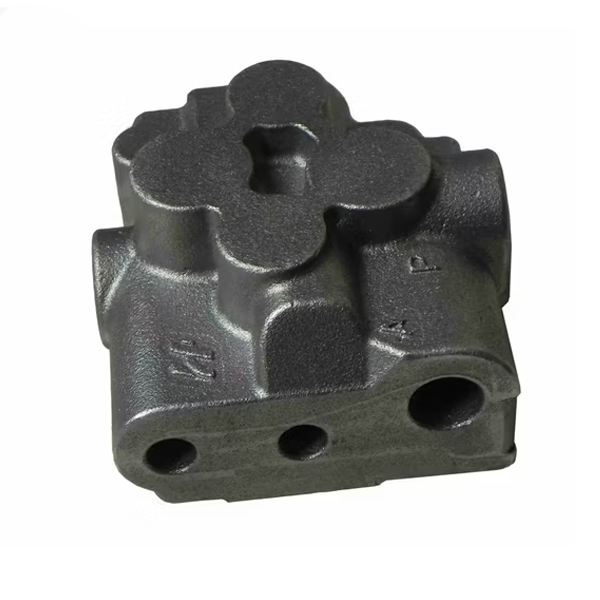
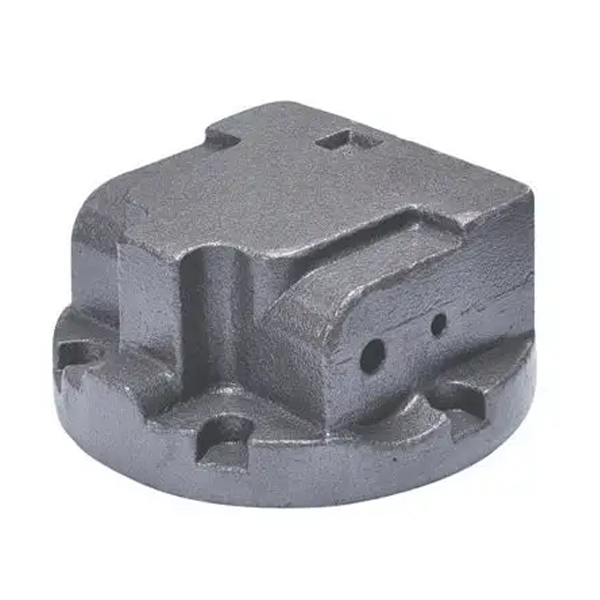
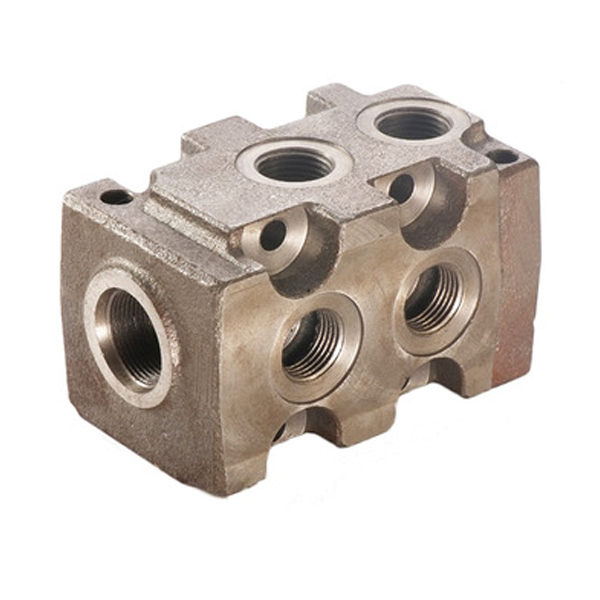

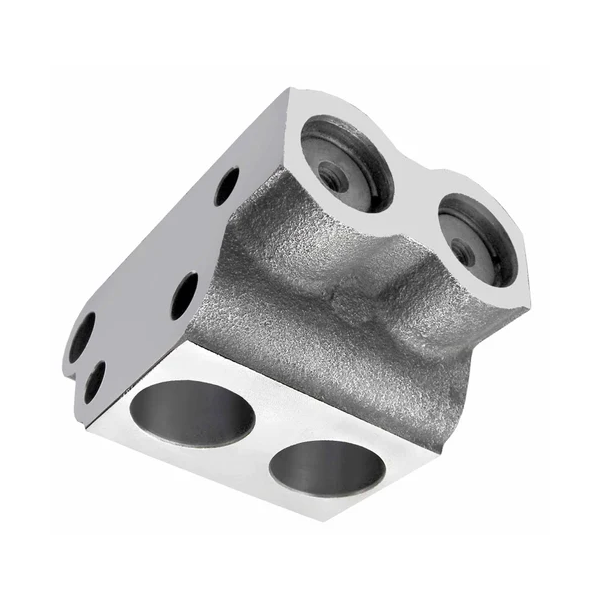
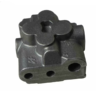
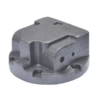
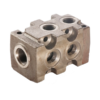
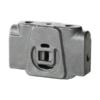
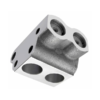
Jiangsu Shengrong Casting Factory strictly controls the casting quality of hydraulic valve bodies, high strength, sealing, pressure resistance and service life. Strictly controlled the entire process from material selection, process design, process control.
Name: valve casting
Material: Gray cast iron HT250/GG25/HT300/GG30/QT450-10/GGG45
Standard/tollerance: EN1561-2011/GB/T 9439/GB/T 1348
Size and weight: OEM by drawing/40 days from mold to finished products
Advantages of Shengrong valve casting parts
1. High-precision machining
Dimensional accuracy: The machining accuracy of the internal channels, holes, and sealing surfaces of the valve body is high (usually reaching the micron level), ensuring that the matching clearance between the valve core and the valve hole is uniform and reducing internal leakage.
Surface finish: The flow channel and the sealing surface need to be finely polished or ground (such as Ra≤0.4μm) to reduce flow resistance and avoid valve jamming caused by particle accumulation.
2. Excellent material properties
High-strength materials: Ductile iron and alloy steel (such as 42CrMo) have high pressure resistance, impact resistance, and fatigue resistance.
Corrosion resistance: Through plating (nickel plating, chrome plating), chemical treatment (phosphating)
Thermal stability: The material needs to withstand high temperatures of hydraulic oil (-30℃ to 120℃) without deformation.
3. Optimized flow channel design
Low flow resistance: The flow channel shape has a smooth transition, reducing turbulence and pressure loss, and improving system efficiency.
Anti-cavitation design: Key parts (such as throttle ports) use special structures or hardening treatment to avoid damage from high-speed fluid erosion.
4. Reliable sealing performance
Multi-stage sealing: Combine O-rings, metal seals or composite seals to ensure the reliability of static and dynamic sealing.
Anti-pollution design: Built-in filter or wear-resistant coating to reduce the wear of particles on the sealing surface.
5. Strict durability test
Fatigue test: Simulate high-frequency switching (such as more than one million cycles) to verify life.
Pressure shock test: Withstand pulse pressure of more than 1.5 times the rated pressure without failure.
Applications of valve casting parts
1. Industrial machinery
Application: injection molding machines, machine tools, die-casting machines, stamping equipment, etc.
Function: Through the coordination of directional valves, pressure valves (such as overflow valves) and flow valves, precise pressure control, speed regulation and action sequence control can be achieved.
2. Engineering machinery
Application: excavators, loaders, cranes, bulldozers, etc.
Function: The multi-way valve group controls the compound actions of multiple actuators (such as the coordinated operation of the boom and dipper of the excavator), and the load-sensitive valve realizes the flow distribution on demand.
3. Agricultural machinery
Application: tractors, harvesters, irrigation equipment.
Function: The directional valve controls the lifting or steering of agricultural machinery, and the pressure valve protects the system from overload.
4. Automobile and transportation
Application: brake system, power steering, automatic transmission.
Function: The solenoid valve controls the flow direction of the brake fluid (such as the ABS system), and the proportional valve adjusts the size of the power steering.
5. Aerospace
Application: aircraft landing gear, steering gear control, fuel system.
Function: Servo valves achieve high-precision position/speed control, and high-pressure resistant valve bodies adapt to extreme environments.
6. Energy and heavy industry
Applications: wind power variable pitch systems, oil drilling platforms, metallurgical equipment.
Function: Cartridge valves are used in large-flow high-pressure systems (such as metallurgical presses), and safety valves prevent pipeline bursts.
7. Shipbuilding and marine engineering
Applications: ship steering gear, anchor winch, deep-sea operation equipment.
Function: Corrosion-resistant valve bodies adapt to seawater environments, and proportional valves achieve stepless speed regulation.
8. Special equipment
Applications: fire trucks, rescue machinery, military equipment.
Function: Explosion-proof valves are used in hazardous environments, and quick-response valves meet emergency action requirements.
Technical Capability
Advantages of Shengrong valve casting parts
1. High-precision machining
Dimensional accuracy: The machining accuracy of the internal channels, holes, and sealing surfaces of the valve body is high (usually reaching the micron level), ensuring that the matching clearance between the valve core and the valve hole is uniform and reducing internal leakage.
Surface finish: The flow channel and the sealing surface need to be finely polished or ground (such as Ra≤0.4μm) to reduce flow resistance and avoid valve jamming caused by particle accumulation.
2. Excellent material properties
High-strength materials: Ductile iron and alloy steel (such as 42CrMo) have high pressure resistance, impact resistance, and fatigue resistance.
Corrosion resistance: Through plating (nickel plating, chrome plating), chemical treatment (phosphating)
Thermal stability: The material needs to withstand high temperatures of hydraulic oil (-30℃ to 120℃) without deformation.
3. Optimized flow channel design
Low flow resistance: The flow channel shape has a smooth transition, reducing turbulence and pressure loss, and improving system efficiency.
Anti-cavitation design: Key parts (such as throttle ports) use special structures or hardening treatment to avoid damage from high-speed fluid erosion.
4. Reliable sealing performance
Multi-stage sealing: Combine O-rings, metal seals or composite seals to ensure the reliability of static and dynamic sealing.
Anti-pollution design: Built-in filter or wear-resistant coating to reduce the wear of particles on the sealing surface.
5. Strict durability test
Fatigue test: Simulate high-frequency switching (such as more than one million cycles) to verify life.
Pressure shock test: Withstand pulse pressure of more than 1.5 times the rated pressure without failure.
Applications of valve casting parts
1. Industrial machinery
Application: injection molding machines, machine tools, die-casting machines, stamping equipment, etc.
Function: Through the coordination of directional valves, pressure valves (such as overflow valves) and flow valves, precise pressure control, speed regulation and action sequence control can be achieved.
2. Engineering machinery
Application: excavators, loaders, cranes, bulldozers, etc.
Function: The multi-way valve group controls the compound actions of multiple actuators (such as the coordinated operation of the boom and dipper of the excavator), and the load-sensitive valve realizes the flow distribution on demand.
3. Agricultural machinery
Application: tractors, harvesters, irrigation equipment.
Function: The directional valve controls the lifting or steering of agricultural machinery, and the pressure valve protects the system from overload.
4. Automobile and transportation
Application: brake system, power steering, automatic transmission.
Function: The solenoid valve controls the flow direction of the brake fluid (such as the ABS system), and the proportional valve adjusts the size of the power steering.
5. Aerospace
Application: aircraft landing gear, steering gear control, fuel system.
Function: Servo valves achieve high-precision position/speed control, and high-pressure resistant valve bodies adapt to extreme environments.
6. Energy and heavy industry
Applications: wind power variable pitch systems, oil drilling platforms, metallurgical equipment.
Function: Cartridge valves are used in large-flow high-pressure systems (such as metallurgical presses), and safety valves prevent pipeline bursts.
7. Shipbuilding and marine engineering
Applications: ship steering gear, anchor winch, deep-sea operation equipment.
Function: Corrosion-resistant valve bodies adapt to seawater environments, and proportional valves achieve stepless speed regulation.
8. Special equipment
Applications: fire trucks, rescue machinery, military equipment.
Function: Explosion-proof valves are used in hazardous environments, and quick-response valves meet emergency action requirements.
Technical Capability

The production process of Shengrong valve casting mainly includes the following steps:
1. Process design and mold preparation
3D modeling and simulation: Design a 3D model based on the valve body structure, use casting simulation software (such as MAGMA, ProCAST) to simulate the filling and solidification process, and optimize the gating system and riser design.
Mold manufacturing: Use metal molds (such as cast iron molds or steel molds) or coated sand molds. Complex structures may use 3D printed sand molds (such as SLS technology).
2. Material selection and smelting
Material requirements: HT250, HT300 gray cast iron, or ductile iron (QT450-10)
Smelting control:
Electric furnace or cupola smelting, strictly control carbon equivalent (CE), sulfur and phosphorus content.
Ductile iron needs to be spheroidized (magnesium or rare earth alloy) and inoculated.
Smelting temperature: cast iron is usually 1500-1550℃
3. Molding and core making
Sand casting (mainstream process):
Resin sand molding (furan resin or phenolic resin): high precision, suitable for small and medium batches.
Coated sand shell mold: high surface finish, suitable for complex thin-walled valve bodies.
Core making: hot core box or cold core box process is used to make inner cavity sand core, and the core sand needs to have high disintegration (to avoid cleaning difficulties).
4. Pouring and solidification
Poting system design:
Open pouring system (such as bottom pouring) reduces turbulence and avoids slag inclusion and air holes.
Set up risers and chillers to ensure sequential solidification and avoid shrinkage cavities and shrinkage.
Pouring parameters:
Cast iron pouring temperature: 1350-1400℃ (adjusted according to wall thickness).
Pouring speed needs to be stable to avoid gas entrapment.
5. Cooling and sand dropping
Controlled cooling: The casting is slowly cooled in the sand mold (especially the thick wall part) to reduce residual stress.
Vibration sand dropping: The casting and the sand mold are separated by vibration equipment to avoid mechanical damage.
6. Cleaning and post-processing
Remove the pouring riser: use grinding wheel cutting or hydraulic punching machine.
Shot blasting/shot blasting cleaning: remove surface sand and oxide scale.
Heat treatment:
Gray cast iron: stress relief annealing (500-550℃ insulation and slow cooling).
Ductile iron: normalizing or quenching + tempering to improve strength.
Machining reference surface: provide positioning reference for subsequent CNC processing.
7. Quality inspection
Dimension inspection: three-coordinate measurement (CMM) key hole distance and flatness.
Nondestructive testing:
X-ray or ultrasonic flaw detection (internal defects).
Penetrant testing (surface cracks).
Pressure test: perform air pressure or hydraulic sealing test on the valve body flow channel.
8. Surface treatment and rust prevention
Phosphating or blackening treatment: improve corrosion resistance.
Anti-rust oil application: anti-rust oil packaging and delivery.
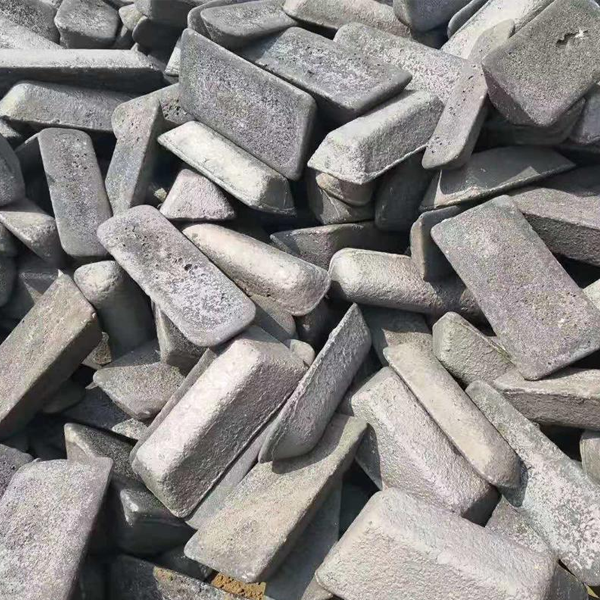
Raw material control
Use a spectrometer to monitor the melting composition (C, Si, Mn, P, S, etc.) in real time to ensure compliance with standards (such as HT250: C 3.0-3.3%, Si 1.8-2.2%).
Ductile iron needs to control the residual Mg (0.03-0.06%) and rare earth elements.Deoxidation: Add aluminum or silicon-calcium alloy to reduce pores.
Spheroidizing: Ductile iron uses the punching method or wire feeding method (spheroidizing rate ≥ 90%).Mold accuracy: 3D simulation optimization of the pouring and riser system (ProCAST/Magma software), the parting surface misalignment is ≤ 0.2mm.Resin sand: tensile strength ≥ 1.2MPa, moisture ≤ 4%.
Lost foam: EPS beads pre-expanded density 0.018-0.022g/cm³.Temperature control:Gray cast iron 1300-1400Ductile cast iron 1350-1420 15-25Pouring flow rate control 0.5-1.0kg/s.Porosity: Moulding sand air permeability ≥80, vacuum before pouring (lost foam).Shrinkage: Add chilled iron to thick wall, riser volume ≥30% of shrinkage compensation area.

Sand casting:
Resin sand: high precision, suitable for small batches of complex parts.
Coated sand: smooth surface, suitable for thin-walled valve bodies.
Used for high-precision, small-size valve bodies to reduce subsequent processing.
During sand casting, the core must be accurately positioned (such as the flow channel) to prevent eccentricity.
Smelting and pouring: strictly control the temperature (1300-1400℃ for cast iron, 1500-1600℃ for cast steel) to avoid oxidation and slag inclusion.
Cooling and cleaning: slow cooling to reduce stress, and remove the pouring head after vibrating the sand.
Heat treatment: annealing or normalizing to eliminate internal stress, ductile iron needs spheroidization.

Key process requirements
(1) Rough machining:Remove the excess quickly and reserve 0.3-0.5mm for finishing.
Equipment: Vertical/horizontal machining center (such as DMG MORI), gantry milling machine.
Use large diameter face milling cutter (φ80-120mm) to process large planes, cutting parameters:
Cast iron: cutting speed 120-180m/min, feed 0.1-0.2mm/tooth..
(2) Semi-finishing
Correct rough machining deformation and improve dimensional consistency.
(3) Finishing:Core requirements:
Valve hole accuracy: IT7 level (diameter tolerance ±0.015mm), cylindricity ≤0.01mm.
Surface roughness: Ra0.8-1.6μm (sealing surface requires Ra0.4μm).
Typical process:
Use diamond or CBN boring tool, micro cutting (cutting depth 0.05-0.1mm).
Cast iron valve hole fine boring parameters: speed 1500-2000rpm, feed 0.05-0.1mm/rev.
Valve seat grinding:
Use ball end milling cutter or special grinding head to process conical sealing belt (such as 60° cone angle).

X-ray inspection: detect internal shrinkage holes and cracks (in accordance with ASTM E802 standard).
Ultrasonic testing: used when the wall thickness is ≥20mm.
Pressure test: 1.5 times the working pressure for 5 minutes without leakage. The coordinate measuring machine (CMM) detects the hole distance (±0.02mm) and coaxiality (φ0.03mm).
The pneumatic measuring instrument measures the valve hole diameter (resolution 0.001mm).
The valve core is assembled simulated to test the switching resistance and leakage (such as ≤10mL/min).
1: Advanced technology and equipment standards
Advanced technology: Sand casting, precision casting, and lost foam casting process. Casting sizes according to customer requirements, weights ranging from 0.5kg to 10,000kg
Automation equipment: Equipped with automated production lines, intelligent melting furnaces (medium frequency/high frequency induction furnaces),
Inspection equipment: Chemical composition/spectrometer and mechanical property inspection equipment, three-coordinate measuring machine (CMM), X-ray flaw detector, spectrometer, ultrasonic testing and other high-end quality inspection methods.
2:Quality management system
ISO 9001 (quality management system)
IATF 16949 (automotive industry quality management system, such as automotive parts)
ASTM/EN/JIS and other international material standards.
3:Customization capability
Customized production according to customer drawings, customers only need to pay half of the mold fee to develop new castings. The mold time is short, only 20 days, and the casting time only 10 days. Machining 10 days.
Free express sample to customers, mass production after customer samples are confirmed to be fully qualified. Our company does not require customers to place a minimum order quantity, satisfying customers with a variety of choices
4:Competitive prices
Our company’s prices are very competitive in the industry, and the specific price depends on the casting drawing and the customer’s order quantity. Welcome to inquire








Carbon, silicon, manganese, sulfur, phosphorus, chromium, nickel, copper and other elements

Tensile strength, yield strength, elongation, hardness, impact strength

Three-coordinate inspection, non-destructive testing, pressure testing, etc.

Every parts we will use anti-rust oil packing or primer, keep every parts in good condition after long time shipping.For small parts, we use wood box pallet packing.For bigger parts with pallet packing

Jiangsu Shengrong High end Equipment Manufacturing Industry Co., Ltd is a professional iron casting foundry about 26,000 square meters, Investment of 80 million yuan,include intermediate frequency furnace, new east Seoul horizontal line, cast star horizontal line, micro crystal automatic casting machine, 40T mixer and 20T mixer, core-making machine, shot blasting machine, machining center, inclined rail lathe, slot machine, vertical lathe, flat rail lathe and other equipment.Testing equipment:spectrometer, tensile testing machine, hardness tester, etc., and supporting chemical testing laboratories. Mainly engaged in: mechanical parts, auto parts, industrial pump parts, bearings and transmission parts manufacturing. Company’s main business: QT450-12, 500-7, 600-3 ball mill castings and HT250, HT300 gray iron castings and cast steel, stainless steel and other business, with the increase of business volume, the production is not only to meet the main business, while the product after the process of product processing business development, so that enterprises diversified production. Now the company has more than 100 employees, including a professional management team and new product development.
CONTACT
Get In Touch